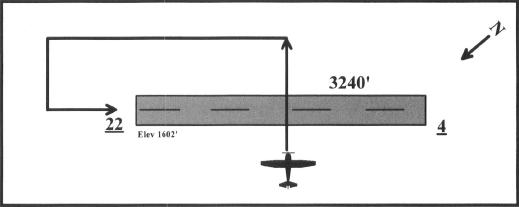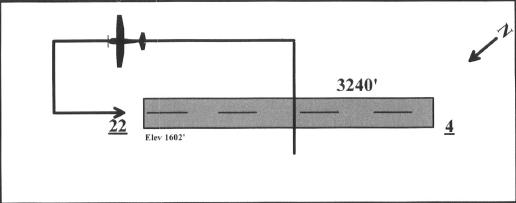Flights of 13MIKE
by Fred J. Calfior and Douglas W. Miller
FLIGHT |
Takeoff:
"Good! A little scoot of power and keep us moving as we line up on the centerline of the runway. Remember - that's right - flaps are at 10 degrees, fuel is good, trimmed properly, oil temperature and pressure are within limits. Keep rolling and now go!"
1) Record TIME____________________________
2) Release brakes and taxi onto runway 29L
3) Advance power to "FULL"
4) Maintain centerline of runway
5) At 50 knots airspeed lift nose wheel off runway
6) At 70 knots ease back on the yoke to establish a 10 degree pitch up attitude
7) Maintain a climb AIRSPEED of 80 knots
8) Raise Gear when there is no more runway to land on
9) At "500" feet above ground level raise the FLAPS to "0"
10) At "1000" feet AGL reduce power to about "2300" RPM
"Now that we're established in the climb, let's try an aileron roll! 1'll bet you didn't know this puppy could do one, did you? Well, not very good - it stalls out when you're inverted, so maybe we better not try that just yet! Let's do like we did on the last f ight, and lower our nose for a 100 knot climb to keep the engine cool. "
Climb out:
1) Continue your climb to "3500" feet
2) Increase AIRSPEED to "100" knots
"It won't take long for you to intercept that 170 radial out of Los Angeles, so stay with this airplane. By the way, that takeoff was very well done!"
3) When the NAV 1 CDI is two and a half dots RIGHT of center, start a LEFT turn to a heading of "170"
4) Start to roll out when you see "180" in the DG window
5) Maintain a heading of "170" (watch the winds)
6) Track outbound on the LOS ANGELES VOR 170 radial
** "From the action of your Number 1 VOR CDI, from what direction is the wind blowing - LEFT or RIGHT?"_____(20 pts)
Level off:
1) Begin to level off when the altimeter reads "3400" feet
2) Maintain "3500" feet
3) Reduce power to about "2200" [2400] RPM
4) Press "P" to pause the simulation
5) Record your:
NAV 1 DME DIST______________(25 pts)
NAV 2 DME DIST______________(25 pts)
ALTITUDE____________________(20 pts)
AIRSPEED____________________(15 pts)
VSI_________________________(15 pts)
6) Press "P" to continue the simulation
"Hey look! There's Flipper playing with Shamu!! Now, it's not like we have a wealth of visual landmarks here, but we have VORs! See how this all prepares you for instrument flying also, even though you're just flying visual? WOW, there's a mermaid!! Watch that Number 2 VOR - never mind the mermaid! Buffalo Burgers ho!!!"
Course change:
1) When the NAV 2 CDI needle is one half dot to the RIGHT, start a LEFT turn to a heading of "150"
2) Maintain "3500" feet and track inbound on the SXC "330" radial
3) Select DME "NAV 2"
"This time, do you have an airport traffic area to be concerned about? Ah, no you don't! Avalon has no control tower, so therefore it has no ATA. Got you! It does have a UNICOM, and I'd say about seven miles out from Santa Catalina VOR, let's call and give UNICOM our position and ask for the altimeter setting and active runway. It will be on frequency 122. 7. "
Descent:
1) When NAV 2 DME DIST reads "7.0", tune COM to "122.7" (Catalina UNICOM)
You:
"CATALINA UNICOM, CESSNA 13MIKE IS FIVE MILES NORTH AT 3500 FEET, FOR LANDING ADVISORY."
Catalina UNICOM:
"CESSNA 13MIKE, WINDS ARE 210 AT 8, RUNWAY 22 IS THE ACTIVE. TRAFFIC PATTERN ALTITUDE IS 2600 FEET, ALTIMETER IS 29.96. PATTERN IS EMPTY."
You:
"13MIKE WILL OVERFLY THE FIELD AT 2600 FEET, AND ENTER A LEFT DOWNWIND FOR RUNWAY 22."
2) Set ALTIMETER, set DG, and check FUEL
3) When NAV 2 DME DIST reads "5.0", set CARB HEAT to "ON" and reduce power to about "1600" [1900] RPM
4) Descend to "2600" feet
"That was well done. Since we're in the approach descent, let me tell you about the spared expenses of the runway. I'll tell you what! You tell me what you see as we overfly the field - that'll make it even more noteworthy for you!"
5) When NAV 2 DME DIST reads "3.0", turn left to "140" deg.
"Nice move there! I see you've adjusted your path so that you'll fly almost a right angle over the runway in order to have a nice 100 degree turn to the downwind. Good thinking! Go ahead and take some more power off - you don't need what you're carrying."

Figure 4.2. Overfly runway for Left Downwind runway 22
6) Reduce power to about "1500" [1800] RPM
"HOLY COW!? Is that all you have to say about the runway -HOLY COW? It's got a few potholes and rough spots on it, doesn't it? Well, that's why I'd like you to do a soft field landing this time, so that we can cushion it somewhat. It's not too bad really, but just something for you to be aware of. Being on frequency 122.7, who are we now concerned about talking to? That's right, any traffic that's out there - which we know ain't there, but give your reports anyway for those possibly arriving, who haven't called in yet."
You:
"AVALON TRAFFIC, CESSNA 13MIKE IS OVERHEAD THE FIELD AND ENTERING A LEFT DOWNWIND FOR RUNWAY 22 - AVALON."
Approach:
1) When you are over the runway, set GEAR "DOWN"
2) When you have slowed to 90 knots, set FLAPS to first notch
3) After overflying the runway, give yourself room before turning downwind so you are not too close to the runway
"Stay at 2600 feet until you get abeam of your point of intended landing. Good - that's great! Watch your distance from the runway off your left side. It's looking a little bit wide, so bring it in just a scootch. What's a scootch, you say? Come on, it's the same thing as a phlegma! You young kids don't hardly know anything about good speaking nowadays!"
4) Press "P" to pause the simulation
** 5) Record your:
ALTITUDE_____________________________(25 pts)
VSI__________________________________(25 pts)
RPM__________________________________(20 pts)
AIRSPEED_____________________________(20 pts)
HEADING______________________________(15 pts)
CARB HEAT____________________________(10 pts)
6) Press "P" to continue simulation
You:
"AVALON TRAFFIC, CESSNA 13MIKE IS ON LEFT DOWNWIND FOR RUNWAY 22, FULL STOP, AVALON."
7) When abeam the approach end, reduce power to about "1400" [1700] RPM and try to maintain a 400 ft per minute descent rate
8) When the end of the runway is at your 7 o'clock position, turn LEFT "90" degrees to establish your BASE leg of the approach

Figure 4.3. Left Downwind turning Left Base for runway 22
You:
"AVALON TRAFFIC, CESSNA 13MIKE IS ON LEFT BASE FOR RUNWAY 22, FULL STOP, AVALON."
9) Set FLAPS to second notch (20 degrees)
10) When runway 22 is at your 10 o'clock position, start a "90" degree LEFT turn to establish your FINAL leg of the approach
You:
"AVALON TRAFFIC, CESSNA 13MIKE IS ON FINAL FOR RUNWAY 22, FULL STOP, AVALON."
"You're just a tiny bit off that centerline. Make slight heading adjustments to compensate for the winds, which cause those inadvertent overshoots or undershoots."
11) When established on the FINAL leg, set FLAPS to third notch (30 degrees)
12) Airspeed should be 70 knots
"This is the last time you'll hear me say this today! Adjust height with power, and airspeed with pitch. I'd simply feel incomplete if I didn't harp on that, and nag you about it!!!"
13) When the altimeter displays "1900" feet, press "P" to pause the simulation
** 14) Record your:
AIRSPEED______________________________ (20 pts)
VSI____________________________________ (20 pts)
HEADING_______________________________(15 pts)
RPM___________________________________ (15 pts)
FLAPS_________________________________ (15 pts)
15) Press "P" to continue the simulation
"A soft field landing is exactly the same as a normal landing, except yoil will carry a little more power, like about 1200 RPM, to cushion it. We should hardly even know that we've touched down. Also, hold that nose up as long as you can until it must fall down on your rollout. "
16) When you are 10 to 20 feet off the runway, reduce power to about "1200" RPM, and start to slowly pitch the nose of the aircraft up to slow your descent and establish a touchdown attitude.
"WATCH YOUR AIRSPEED! The same restrictions apply as with a normal landing. Be careful not to stall the aircraft. Don't let your airspeed drop below 60 knots. If it does, Shamu leaps out of the water, eats you up, and I don't get my free Buffalo Burger! So, a lot is riding on this for me!"
17) When you are five feet off the runway, hold the nose of the aircraft up and allow the airspeed to SLOWLY bleed off. Your aircraft will settle onto the runway while you follow the centerline.
"Easy, easy! Of course you'll float down the runway more than normal because of the bit of additional power you have. Don't be impatient, let the aircraft settle onto the runway slowly. "
18) After touchdown, reduce power to 600 RPM
19) Apply the brakes
20) Taxi the aircraft off the active runway to the left
21) Stop on the taxiway and set CARB HEAT to "OFF"
22) Set FLAPS to "0"
"What a garden spot! Don't forget to transmit that you're off the active. We'll need some fuel. Hey, look at the UNICOM operator waving at us from his building! He better not say the restaurant is out of Buffalo Burgers!!"
You:
"AVALON TRAFFIC, CESSNA 13MIKE IS CLEAR OF THE ACTIVE, WILL TAXI FOR FUEL."
23) Taxi to the large square with an "F" in the middle of the square
24) Upon arrival at the fuel station, set brake, turn STROBE "OFF", and turn MAGS to "LEAN" to shut down your engine
"We'll close our flight plan from a phone inside. I've got to call my wife anyway to tell her we didn't get eaten up by ORCA the killer whale! What say we go in and feed both, this old flight instructor, and pilot extraordinaire!!! 1 think 1 hear those woolly beasts calling us!!"
** 25) Record the TIME___________________________________ (5 pts)
TOTAL POSSIBLE POINTS FOR THIS FLIGHT IS 385
Table of Contents
Previous Section: Flight Scenario Four: Torrance to Avalon: Preflight
Next Section: Flight Scenario Five: Lansing to Aurora
